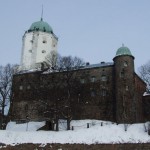Vyborg Castle (Russia)
Then Swedish men headed for heathen land
Hardships, and wounds, and troubl’s to withstand.
Pagans were fighting, knowing no pain;
Koenig commanded those in campaign
Fortress to build at a whatever price
Right where the land of the foreign woods lies
And at the end of the world of our Lord…
…Vyborg, the fortress, stands in the East…
(Eric’s Chronicle, XIV century)
The city of Vyborg (and Vyborg Castle as well) lies in the north-eastern part part of Karelia isthmus along the Finnish Gulf. Slavic-Karelian settlement existed on this territory, where today’s park Mon Repos is situated, approximately from the XI century. Many different nations — Karelians, Swedes, Russians, Germans, Finns, and others — contributed to the rich history of the city. Many times the city changed hands from Swedes to Russians, back and forth, and, virtually, for a long period of time was the border line between the two states — Russia and Sweden.
Vyborg’s foundation date is not very clear, as well as the location of the “old” city. In Russian historical tradition the problem of dating the foundation of the city is solved in a compromise way: the year when this settlement is first mentioned in Novgorod chronicles or other written sources is considered to be the date of its foundation. According to this point of view, Vyborg was founded in 1293, when Vyborg Castle was founded. The latter was founded in the wake of the third Swedish crusade to the Karelian land, which formally belonged to Novgorod at that time.
The first two crusades were stopped by Alexander Nevsky. In 1293, the Swedish army landed from their ships on the shore of the Finnish Gulf in the vicinity of the present day Vyborg. The inspirer of the crusade and of the construction of a castle was Torkel Knutsson (regent for underaged king Birger, the de-facto ruler of Sweden at that moment). It is this marshal, Torkel Knutsson, who is believed to be the founder of Vyborg city, and a monument dedicated to him is standing on the square in front of the former city council. The invaders destroyed a Karelian village, which was built here, and tore down a little guard point on top of a small elevated island in a narrow strait. Having estimated its crucial strategic location, the Swedes founded a castle on the island and called it Vyborg (Holy fortress).
As they gained control over this territory, Swedes secured their dominion over a crucial trading artery — the only access for Rus to the waters of the Baltic Sea. The third crusade was successful for the Swedes: they captured the lands of southern Karelia (the territory of today’s eastern Finland along with Karelian isthmus) all the way down to Sestra River.
Novgorod citizens in their turn aspired to take over Vyborg. According to a number of authorities, Novgorod troops approached Vyborg walls again in 1350 or in 1351. They managed to destroy the town, defeat the enemy who came out of the fortress and drive them back into the castle. Nevertheless, they could not take Vyborg, which was their main goal. A similar campaign was undertaken in 1411. Vyborg became the main front post of the Swedes in the east, and even more so after the former Swedish fortress, Landskrona (situated at the mouth of the Okhta River on the territory of today’s Saint-Petersburg), was destroyed in 1301.
Strategic military situation in this area changed greatly when Moscow annexed Novgorod. The foreign policy of Moscow grand dukes, the main rule of which was to take their neighbors’ lands whenever there was an opportunity, did not leave Vyborg citizens any hopes of a peaceful existence. When Muscovites had established their control in annexed Novgorod territories they took on Karelia. In 1495, huge (for those times) Moscow army of 60,000 soldiers, not including fighters’ servants, put Vyborg under siege on all sides. The Vyborg fortress had been withstanding a heavy siege for three months and it was able not to give in. Advance of the Grand Duchy of Moscow to the north-west temporarily ceased. An event that happened on November 30 became the decisive moment of the siege in 1495. When Russian warriors started their final storm and the fortress garrison was about to surrender the Swedish commander ordered to blow up gun powder supplies in Andreas Tower. The explosion of great impact tore down the tower, kicked back storming ladders and killed many of those who were besieging the fortress. According to another theory, the explosion was organized by a Moscow voivode, but he did more damage to his own people than to the enemy. Whatever the real story was, the besieging troops had to retreat. This case in the history of the city was dubbed “The Vyborg Thunder.”

